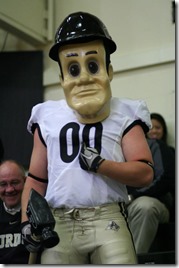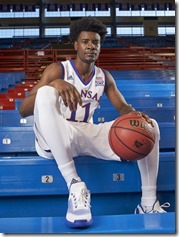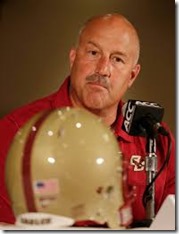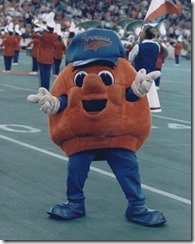For 2017, instead of previewing conferences division-by-division, I decided to rank the 64 Power Five teams and count down from the bottom.
I created a ranking system based heavily off of Bill Connelly’s S&P+ rankings: half of the ranking comes from the S&P rankings from the past five seasons among Power Five teams (1/3 of that number is 2016’s ranking; 1/3 is the average from 2014-2016, 1/3 is the average from 2012-2016); half comes from two component parts of his 2017 S&P+ projections, weighed evenly – recruiting impact and returning production – and ranked 1 through 64. The ranking itself skews towards emphasizing where the teams were according the 2016 S&P+. I think it serves as a decent way to sequence these previews.
Here we go:
64. PURDUE![pur17 pur17]()
#7B1G West, #14 B1G
3-9 (1-8) in 2016
After Joe Tiller retired following the 2008 season, Purdue gave Danny Hope and Darrell Hazell four years each as the head coach before firing them: Hope’s mediocre 22-28 record looks pretty decent in comparison to Hazell’s 9-33 mark in West Lafayette (he was let go following a loss to Iowa last October). The Boilermakers have finished last in all three seasons of the Big Ten West’s existence; they’ve beaten Illinois twice and upset 6-7 Nebraska for their only three wins in that span. Over the four-year Hazell era, only Kansas was comparably bad among Power Five programs.
Purdue lured Jeff Brohm from Western Kentucky this past offseason, and it was a great hire. Brohm has geographically proximate roots, won double digit games in his last two seasons with the Hilltoppers, and his WKU offenses lit up the scoreboard with fireworks in the passing game. From a stylistic standpoint, he’s far more Tiller than Hazell. Staid Big Ten cavemanball was an approach that failed miserably with the last regime, so the Boilermakers went back to their turn-of-the-century roots, in a sense, with Brohm.
The short-term future is bleak. WKU had a great foundation when he stepped in… Purdue does not. David Blough showed flashes of promise from the quarterback spot, but led the country in interceptions last season. The defense returns eight starters (including Glenn Robinson III’s younger brother, DT Gelen), but conceded 38.3 points per game last season and lost their best player, DT Jake Replogle.
Brohm was a great choice, but the degree of difficulty for his first Power Five gig is very high. Perhaps he’ll bring success to West Lafayette eventually – 2017 will be rough.
63. RUTGERS![rut17 rut17]()
#7 B1G East, #13 B1G
2-10 (0-9) in 2016
It’s a minor upset that Rutgers didn’t finish last in these rankings, but the Scarlet Knights staked a credible claim as the worst Power Five team in the country last season (they were, according to S&P+). They went winless in Big Ten play and somehow managed to get shut out by Ohio State, Michigan, Michigan State, and Penn State, tallying an aggregate 224-0 margin of defeat against those four teams. Of course, the 78-0 bloodletting at the hands of Michigan in Piscataway will endure as the definitive memory of the 2016 Rutgers football team.
It’s difficult to even mention Rutgers in the context of this preview without making mention of the Big Ten’s horrible decision to promote them to the Power Five in the first place; a scarlet and black ball-and-chain will remain on the ankle of the league long after the cable subscriber revenue stream (which was Rutgers’s main draw in the first place) dries up. They weren’t that bad of a program at the time they were added – mostly due to Greg Schiano – but the hilariously inept mismanagement of Kyle Flood dragged Rutgers back down to their historical norm.
Chris Ash, former Urban Meyer DC and branch of the Bret Bielema coaching tree, had an awful offense in his first season as head coach; he hired former Minnesota HC Jerry Kill as the offensive coordinator to right the ship. Kill – whose well-documented health issues forced him to leave Minnesota – will have to choose between a half-dozen uninspiring options at quarterback. At least electric scatback Janarion Grant returns from injury. Rutgers draws Illinois and Purdue from the West so they could improve on their 2-10 record, but will be one of the worst Power Five teams again.
[57-62 after the JUMP]
62. KANSAS![kan17 kan17]()
#10 Big 12
2-10 (1-8) in 2016
In 2007 – what had to be the most bizarre college football season of all time – Kansas won 12 games and the Orange Bowl, staying in the race for a BCS title game appearance until the bitter end. Mark Mangino was fired two seasons later amid allegations of player mistreatment, and the Jayhawks have been dreadful ever since. In the seven seasons under Turner Gill, Charlie Weis (and interim coach Clint Bowen), and David Beaty, KU has gone a combined 14-70, an unfathomably bad record for a power conference program. They’ve only won four Big 12 games in that span.
Weis was an enormous failure in many ways, but his recruiting style – pursuing JUCOs at any and every available opportunity – left the foundations of the program completely decimated. David Beaty went 0-12 in 2015, his first season after stepping into that mess and received a contract extension after last season… after going 2-10. A hilarious late-season upset of Texas at home may have played a small role in that, but it’s likelier that KU simply realized the magnitude of the overhaul the program desperately needs and was willing to invest in Beaty to do the job instead of cycling through coaches every few years.
They’ll be bad again, but there could be tangible signs of improvement. New offensive coordinator Doug Meacham arrives from TCU; his Air Raid offenses at his previous job were some of the best in the country in 2014 and 2015. On defense, the Jayhawks have DE Dorrance Armstrong – one of the better pass rushers in the Big 12 – as well as DT Daniel Wise and S Mike Lee; there are big holes on that side of the ball, of course, but some playmakers as well. While Beaty may be slowly moving everything in the right direction, there will be at least one more year at or near the Big 12 cellar.
61. ILLINOIS ![ill17 ill17]()
#6 B1G West, #12 B1G
3-9 (2-7) in 2016
It was always going to be difficult to dig out of the wreckage of the Tim Beckman era; Bill Cubit was promoted from offensive coordinator and given one (5-7) season before a new athletic director fired him and made a splash by hiring longtime NFL head coach Lovie Smith, who hadn’t coached at the college level in decades. The Big Ten West is perhaps the weakest division in the Power Five, so plenty of people thought that Smith could gain some traction and drag Illinois from the division cellar.
Early returns haven’t been great. His recruiting has been underwhelming – even for Illinois’s standards – and while the program is still recovering from Beckman’s disastrous tenure, a 3-9 campaign in his first season in Champaign didn’t offer much hope for the Illini. They did take care of Rutgers and sprung an upset over a Michigan State team that was in freefall mode by that point.
Illinois did have some big play potential on the offensive side of the ball and return their primary skill position playmakers from a season ago. JUCO transfer Dwayne Lawson enters the picture at quarterback and he – or whoever else wins the job – will be frequently targeting Malik Turner, who had 712 yards and 6 touchdowns last season; if Mike Dudek can stay healthy (he hasn’t played for two straight seasons), the Illini will have a terrific WR duo. They had a quality defensive line last season; almost all of the players from that position group are gone. Even though five of the back seven starters return, they’ll have to improve quite a bit to mitigate losses on the line.
Smith signed a six-year contract, so he’ll have time to try to build the program, even if Illinois is battling with Purdue at the bottom of the division again this season.
60. BOSTON COLLEGE![bc17 bc17]()
#7 ACC Atlantic, #14 ACC
7-6 (2-6) in 2016
The last two successful coaches at Boston College – Tom O’Brien and Jeff Jagodzinski – ended their careers in Chestnut Hill in strange fashion: O’Brien made the lateral move to NC State, and Jagodzinski was fired after going 20-8 and interviewing for an NFL head coaching job. Frank Spaziani lasted four mediocre seasons before getting fired; Steve Addazio is entering his fifth season with a 24-27 record (but three bowl appearances).
Addazio, who worked under Urban Meyer at Florida, has a background as an offensive line coach, but his Boston College offenses have been dreadful since he arrived. In 2015, they went 3-9 despite having a Don Brown-led defense that was one of the best in the country, losing their first three ACC games by scores of 14-0, 9-7, and 3-0. Last season wasn’t much better – even though they made it to six wins and defeated Maryland in the bowl game, they scored just 12.0 points per game in conference play. It was offensive coordinator Scot Loeffler’s first season at Boston College; his previous stints at Virginia Tech and Auburn aren’t encouraging.
Losing Brown before last season wasn’t devastating. The BC defense was still very aggressive in the front seven and DE Harold Landry is a legit star, but there still was some regression, and the best programs in the Atlantic (Clemson, Florida State and Louisville) torched that defense, outscoring the Eagles 153-24. Only four significant contributors are gone from last season, so they should still be one of the better teams in the ACC on that side of the ball. It’s hard to see much improvement coming on offense though. Four offensive line starters return, but they had one of the most anemic running games in the Power Five last season. Their quarterback is gone.
Boston College might make a bowl game again – they’ll probably have to beat NIU, Central Michigan, and UConn out of conference to get there – but likely will finish near the bottom of the division with Syracuse and Wake Forest. In any case, it will be extremely ugly.
59. VIRGINIA![uva17 uva17]()
#7 ACC Coastal, #13 ACC
2-10 (1-7) in 2016
Bronco Mendenhall’s decision to leave BYU after a successful 11-year stint as the head coach came as somewhat of a shock; that he took the Virginia job in a suddenly deep ACC Coastal division seemed like a step down in some ways, even if he was moving up to the Power Five. His predecessor, Mike London, recruited well in Charlottesville, leaving blue-chippers like DE Andrew Brown and star FS Quin Blanding (who are seniors in 2017) on the roster, but after an 8-5 campaign in his second season at UVA, London went a combined 15-33 over the rest of his tenure.
Mendenhall’s first season at Virginia was brutal: they lost the season opener to FCS Richmond by three scores, dropped a clunker to UConn after outplaying the Huskies, and won just one ACC game (against Duke) en route to a 2-10 season in which they lost their last seven games. The Cavaliers almost sprung one of the biggest upsets of the season against Louisville at home and led in the final minute of the game, but a late touchdown with 13 seconds left helped the Cardinals escape with a win.
The prognosis isn’t much better for 2017. Even though QB Kurt Benkert returns, as does his top two targets in the passing game, the loss of versatile RB Taquan Mizzell will place much more responsibility on their shoulders. Mendenhall brought in three grad transfers to shore up the offensive line. Mendenhall’s background is on the defensive side of the ball, and the Virginia defense was marginally better than the offense a year ago, particularly because of the run defense. LB Micah Kiser has been extremely productive; along with Brown and Blanding, there’s definitely talent there.
Still, UVA is younger than they were last season, and Mendenhall has a difficult job ahead if he’s going to move up the ladder in a division that has quite a few good coaches who have a head start on him.
58. VANDERBILT![van17 van17]()
#7 SEC East, #14 SEC
6-7 (3-5) in 2016
Vanderbilt is one of the toughest jobs in the Power Five. Before a 7-6 season in 2008 under Bobby Johnson, the Commodores hadn’t had a winning record since 1982; James Franklin took the program to new heights in 2012 and 2013, going 9-4 in each season, notching wins over Auburn, Florida, Georgia, and Tennessee (twice). Franklin struck while the iron was hot, taking the job at Penn State as the nucleus of his team graduated.
Derek Mason – formerly the defensive coordinator at Stanford – was brought in to replace Franklin, and even though he went 3-9 (and winless in the SEC) in his first season, the Commodores’ win total improved in 2015 and again in 2016 He’s built a relatively stingy defense – though the heart and soul of that defense, All-American LB Zach Cunningham, is gone – but the offense has yet to come around: they lost two games in which they held SEC foes (South Carolina and Florida) to just 13 points in 2016. An upset win over Tennessee in the regular season finale delivered a bowl appearance in year three of Mason’s tenure.
The Commodores return nine starters on offense, and even though they improved their points per game total (from just 15.2 in 2015 to a better-but-still-bad 23.0 in 2016), there are still a ton of questions. Returning starting quarterback Kyle Shurmur threw more interceptions than touchdowns last season; RB Ralph Webb is entering his fourth season as a starter and has run for 3,347 yards – but Vanderbilt will need a legitimate passing game to create more balance offensively.
The defense should be solid, though they’re likely to regress some with Cunningham’s departure. The secondary should be pretty decent: Ryan White and Arnold Tarpley are a solid safety tandem and CB Tre Herndon is a multi-year starter. Mason’s 3-4 defense doesn’t have the size along the defensive line required to free up linebackers to make tackles, and without an All-American type patrolling the middle of the field and blowing up plays in the backfield (Cunningham had 16.5 TFL a year ago), they’re likely to get manhandled by the better rushing attacks in the SEC.
With Kansas State from out of conference and Alabama from the SEC West appearing on the schedule, returning to a bowl game would be an accomplishment, especially as most of the rest of the SEC East is projected to improve.
57. SYRACUSE![syr17 syr17]()
#6 ACC Atlantic, #12 ACC
4-8 (2-6) in 2016
Over more than a decade as head coach, Paul Pasqualoni posted a record of 107-59-1 at Syracuse; since they fired him following the 2004 season, they’ve been a combined 53-93 under four different coaches. Dino Babers is the latest, and he’s evidence that Syracuse was really willing to shake things up: Babers is an Art Briles acolyte who mimics the extreme tempo and vertical spacing characteristics that made those Baylor offenses so successful. Babers won the MAC East in his first season at Bowling Green and won the conference in his second – Matt Johnson threw for 4,946 yards, 46 touchdowns, and just 8 interceptions in that 2015 season.
The Orange’s new style is unique among ACC teams, and even though they only went 4-8 last season, there were some encouraging signs. Babers’s offense clicked well when QB Eric Dungey was healthy and Syracuse was 4-4 before he was injured – including an impressive win over Coastal champion Virginia Tech. Amba Etta-Tawo became the top WR, production-wise, in the ACC – even though he’s gone, Ervin Phillips is one of the best returning receivers in the league. A completely new offensive line last season returns intact, and should improve greatly two seasons removed from a drastic shift in offensive philosophy. Dungey is back and should put up big numbers over the course of the season if he doesn’t get hurt again.
The defense was a huge problem a year ago: a brutal spate of injuries in the secondary played a huge role, but the point totals given up were inexcusable – 76 to Pitt, 62 to Louisville, 54 to Clemson, 50 to Notre Dame, 45 each to USF and Florida State. Most significant contributors return, as Syracuse welcomes back 13 of its top 14 tacklers. There are plenty of players with starting experience, so some improvement should be expected – partially because it seems like it would be hard to be anywhere near that bad again.
Unfortunately Syracuse is in the ACC Atlantic: annual matchups with Clemson, Florida State, and Louisville are tough enough, but NC State could be really solid this season and the Orange draw Miami and Pitt from the Coastal as well as LSU from out of conference. A bowl bid would be quite impressive with that slate, even if Babers does have a lot of contributors back.







